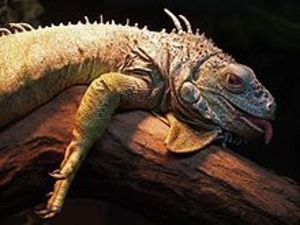Bad iguana care and disease go together. Many diseases can be prevented by proper diet, temperature and sanitation of the cage. Only a veterinarian should diagnose a sick iguana since signs of disease also look like other ailments such as parasite infestation. If possible, bring a stool sample to the vet to help with the diagnosis.
Common Signs of Disease
Common signs of iguana diseases include change of appetite, change in the amount of feces produced, changes in color and problems eating or walking. If the caretaker adopted an iguana or if the iguana is relatively new, then color changes or trouble walking may be the only visual sign of disease. Any color change to the overall body of the iguana that does not have to do with old age, normal shedding or a sexual display may indicate disease, according to Holly Nash, DVM.
If the iguana turns yellow in the gums and mucus membranes, then this could indicate liver disease. If only patches of coffee brown or black are seen, this could be the first sign of “blister disease”, which indicates bacterial infection. Red, swollen scales on the abdomen and limbs usually indicate a parasitic infection.
Iguanas with problems eating such as constantly dropping their food may have mouth rot. Their mouths and gums often change color. Iguanas that have problems moving their hind limbs may have the most common iguana disease of all, metabolic bone disease. This is caused by malnutrition. Adopted iguanas may be so used to a poor diet that they refuse good quality food. If the iguana is not eating proper food, then ask the vet about force feeding and about Vitamin D and calcium supplementations that can be added to the iguana’s food.
Invalid Care
If the sick iguana lives with other iguanas, move the sick iguana to another cage if possible. Other iguanas may harass the sick iguana, according to “The Iguana’s Den: Care and Keeping of Giant Green Iguanas” (Lulu.com; 2005). Be sure to keep the cage scrupulously clean to avoid infections.
Iguanas need to be kept at temperatures of 85 to 90 degrees F in order to help their bodies heal. This helps keep their body temperatures at stable warmth to help promote healing. Since they evolved to live in the South American rainforests, Long Beach Animal Hospital highly recommends all iguanas to live in 90% humidity.
In order to digest the crucial nutrients of Vitamin D and calcium, iguanas need exposure to artificial sunlight. Black lights and aquarium lights just do not give off the required light. Use only UVA or UVB light bulbs to light an iguana’s cage. Use the longest possible bulbs you can find to help heat the iguana’s total body length.
First give the iguana a drink of half Pedialyte for human babies and half water. This will help the iguana’s stomach get used to food and not go into shock at nutrient overload.
Making slurry or a liquid food can help iguanas that are beginning to dehydrate or are refusing food. Ask your vet if unsure about how to make slurry. Place in a blender:
- 2 cups collard greens
- 1 cup dandelion greens
- 2 cups of arugula and/or mustard greens
- 3 cups Pedialyte or similar drink
- 1 cup fruit like melons, figs, strawberries or the iguana’s favorite
Blend until it is the consistency of baby food. Strain through cheesecloth. Feed with a syringe. It may be best to have a helper hold the iguana while you feed. Refrigerate any leftovers. Feed about 1 cup at a time.
In Conclusion
Poor iguana care and disease pop up together but can happen to even well cared iguanas. Through a combination of veterinary help, force feeding and proper environment settings on the invalid’s cage, the prognosis for the sick iguana is good.
Resources
“The Iguana’s Den: Care and Keeping of Giant Green Iguanas.” Meredith Martin, et al. Lulu.com; 2005.
Long Beach Animal Hospital. “Iguana Bone Disease.” http://www.lbah.com/reptile/nshp.htm
Pet Education. “Causes of Iguana Color Changes.” Holly Nash, DVM. http://www.peteducation.com/article.cfm?c=17+1796&aid;=2741
Green Iguana Society. “Green Iguana Quick Help.” http://www.greenigsociety.org/quicktips.htm





